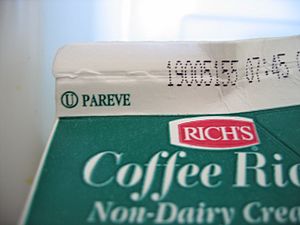Pareve facts for kids
In Judaism, there are special food rules called kashrut. These rules decide what foods Jewish people can eat and how they should be prepared. One important group of foods is called pareve (pronounced PAR-ev). This word comes from a Yiddish word meaning "neutral."
Pareve foods are special because they are neither dairy nor meat. This means they can be eaten with either meat or dairy meals. Foods like fruits, vegetables, grains, fish (only kosher fish), and eggs are pareve. Even things like water and salt are pareve.
Jewish law says you cannot mix milk and meat. You also can't eat them at the same meal, or eat dairy soon after eating meat. Pareve foods are neutral, so they can be enjoyed with either type of meal.
Contents
Pareve Food Rules
Eggs
Eggs laid by a bird are considered pareve. This is because they are separate from the animal. However, if an egg is found inside a bird after it has been slaughtered, it is seen as part of the meat. Most eggs you buy in stores are laid by chickens and are pareve.
Bread
Most common bread must be made pareve. This is because bread is a very common food. It would be easy to forget if it had dairy or meat ingredients. Bread doesn't have to be pareve if it's made in a very unusual shape. It also doesn't need to be pareve if it's eaten on the same day it's made. Even people who are vegetarians must follow these rules if they are Jewish.
Food Contact and Equipment
Sometimes, pareve food might touch dishes that have been used for dairy or meat. Or it might be made in a factory on equipment also used for dairy or meat. Even then, the food usually stays pareve. This means you can still eat it after a meat or dairy meal.
However, if the pareve food touched a dairy dish, you should only eat it on dairy dishes. The same goes for meat. Some products that are pareve but made on dairy equipment have "DE" after their kosher symbol. This tells you not to eat them with meat. But you can still eat them after a meat meal.
Medicines and Vitamins
Medicines you take for health reasons are usually swallowed whole. They don't really count as food. So, the rules of kashrut don't usually apply to them. But Vitamins are seen as nourishment, like food. So, vitamins must follow kosher laws. These rules only apply to things you eat or drink.
Kitchen Utensils
Many kosher homes have two sets of dishes: one for dairy and one for meat. Some homes also have a third set just for pareve foods. Or they might have special cooking tools for pareve items. This helps them prepare pareve foods that can be served with either dairy or meat meals.
Fish
Even though fish is pareve, some Jewish traditions say not to mix fish directly with meat. It's also common not to eat them on the same plate at the same meal. Some traditions, like Chabad, also avoid eating fish with milk. But mixing fish with other dairy products like cheese or butter is usually fine.
Pareve in Stores
Because Jewish law forbids mixing milk and meat, many foods sold in stores are made pareve. This allows people to eat them with either dairy or meat meals. Food companies often use ingredients like soy, tofu, palm oil, or coconut oil instead of dairy or meat. For example, they might use soy cheese instead of real cheese.
Years ago, it was not allowed to eat a pareve food that looked like dairy (like soy milk) with meat. This was because it might confuse people. But today, many pareve foods look like dairy or meat. So, this rule is usually not followed anymore.
Margarine is often used instead of butter to make baked goods pareve. This means the baked goods can be eaten with meat meals.
Pareve and Special Diets
Vegetarian and Vegan Diets
When a food label says "pareve," it might seem like it's good for vegetarians or vegans. But this is not always true. Fish and fish products (like fish gelatin) are pareve. However, they are not vegetarian and never vegan. Honey, eggs, and egg products (like mayonnaise) are pareve and vegetarian, but not vegan.
Some processes can change a meat or dairy product into a pareve substance. For example, rennet (used to make cheese) can come from animal stomachs. But it can still be used to make kosher cheese. However, some vegetarians might only eat cheese made with rennet from plants.
Also, some products might be labeled "vegan" but not be pareve according to Jewish law. This can happen if they had a tiny bit of contact with dairy ingredients or tools.
Allergies
People with allergies to dairy might think "pareve" means "dairy-free." But this isn't always the case. Jewish law has ways to clean equipment that was used for non-kosher foods. But this cleaning might not be enough for someone with a severe allergy.
For example, dairy equipment can be cleaned well enough for rabbis to say that products made on it are pareve. But someone with a strong dairy allergy might still react to tiny traces of dairy left behind. That's why some pareve products might still have "milk" warnings.
If a food accidentally gets a very small amount of dairy (less than 1/60th of the total), it can still be considered pareve. However, people with allergies can be sensitive to even smaller amounts. So, they might not be able to rely only on a "pareve" label.
Images for kids



